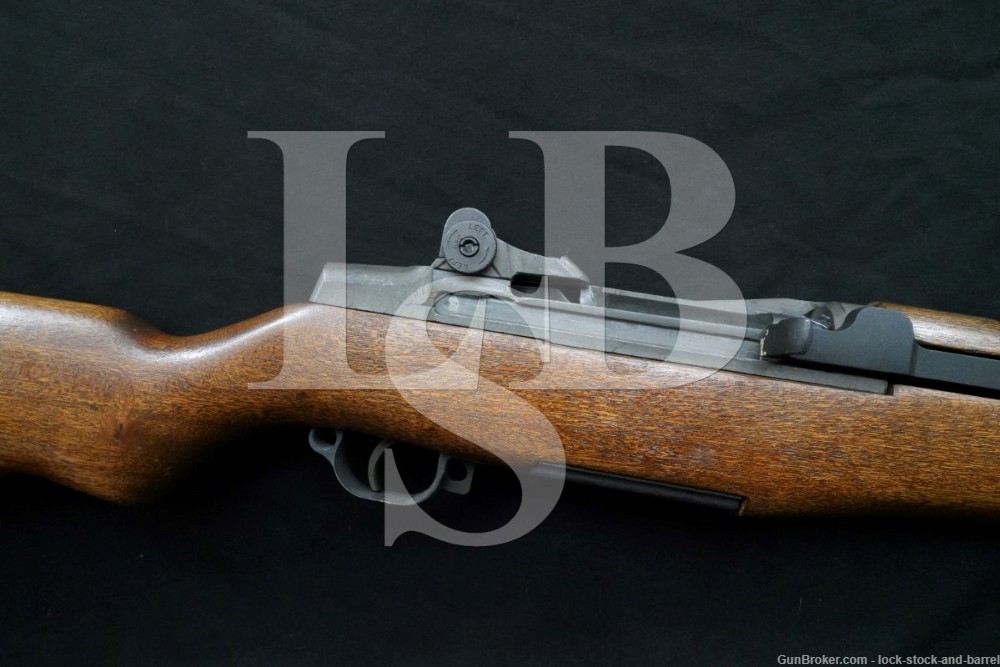
International Harvester M1 Garand Tanker .308 Win. Semi Automatic Rifle
SOLD FOR: $1881
LSB#: 210911DJ30
Make: International Harvester. Arlington Ordnance converted the rifle.
Model: M1 Tanker Garand Conversion
Serial Number: 5184709
Year of Manufacture: Modern Conversion.
The rifle was originally made between 1954 and 1956.
Caliber: 7.62 NATO (7.62x51mm). The 7.62 NATO and the commercial .308 Winchester (7.62x51mm) cartridges are very similar and can be loaded into rifles chambered for the other round. The Winchester .308 is loaded to higher pressures than 7.62 NATO. Check with a qualified gunsmith to determine if .308 can be fired regularly through this rifle.
Action Type: Semi Auto, Fed by En Bloc Clips
Markings:
Receiver: “U.S. RIFLE / CAL. .30 M1 / INTERNATIONAL / HARVESTER / 5184709”
Trigger Group: “D28290-5-SA” – A Springfield part (page 90 of Joe Poyer’s M1 GARAND 1936 to 1957, 6th Edition).
Hammer: “C46008-2 SA”– A Springfield part (page 98).
Safety: “F” – An International Harvester part (page 104).
Follower: “8”– A Springfield part (page 83).
Receiver Leg: “D6528291-AA” – This marking has been restamped improperly. It should read “IHC D6528291-A” (page 29). There are no signs of a reweld. Many of the rifles markings are faint due to refinishing .
Op Rod: “6535382 3 SA” – A Springfield part (page 71).
Barrel:”6” and “ARLINGTON ORD. ARL. VA. 7.62 NATO”. We do not know if the barrel is a converted USGI barrel or a commercial barrel (pages 63 – 65)
Bolt: “D28287-1W.R.A.” – A Winchester part (page 53).
The stock and sights are described below.
Barrel Length: Approximately 18 Inches
Sights / Optics: The front sight is a blade set between two protective wings. The rear sight is a fully adjustable aperture sight. The windage knob is marked “LEFT arrow” twice and “DRC”. The elevation knob is marked from “2-12” in increments of and “WC E”.
Stock Configuration & Condition: The hardwood stock has been cut down from an original. It has a pistol grip, metal nosecaps, stacking loop, two sling loops, and a metal buttplate with hinged metal door for storage in the buttstock. The wood shows scrapes & scuffs. A few have damaged small portions of the surface wood. The LOP measures 13 ¼ inches from the front of the trigger to the back of the buttplate. The stock rates in about Fine overall condition as refurbished.
Type of Finish: Parkerized
Finish Originality: Original to Conversion
Bore Condition: The bore is bright. The grooves near the muzzle are semi bright. The rifling is deep. There is fouling and a freckling of discoloration from oxidation in the grooves near the muzzle. The fouling should clean up some. The bore shows an M.E. of 0.8.
Overall Condition: This rifle retains about 95% of its metal finish. The metal shows several scuffs, scrapes, and small scratches. The rear of the receiver shows discoloration. The markings are defined; some are faded. Overall, this rifle rates in about Very Good Plus to Fine condition.
Mechanics: The action functions correctly. We have not fired this rifle. As with all previously owned firearms, a thorough cleaning may be necessary to meet your maintenance standards.
Box, Paperwork & Accessories: None
Our Assessment: This M1 Garand was originally built in the 1950’s by International Harvester. It has since been converted to “Tanker Garand” configuration. The rifle has been cut down nicely and refurbished. It now fires 7.62 NATO (7.62x51mm) ammunition and has a metal .308 spacer block installed. The spacer block does not allow you to load a clip with .30-06 cartridges into the rifle. This is a nice looking rifle that will add to your collection.
Here is some Tanker Garand information from scott-duff.com/whats-a-tanker-garand/: “The “Tanker Garand” is a “misnomer.” During WWII two separate prototypes were developed for paratroop use. The first was the M1E5. The M1E5 had a short barrel and a folding metal stock. It was developed and tested in the Summer of 1944, but then abandoned because of the loud report and large muzzle flash from the short barrel. In the fall of 1944 the Pacific Warfare Board ordered a test quantity of 150 M1 Rifles to be shortened and tested for jungle and paratroop use. These conversions were rather crudely done in the Pacific Theatre of Operations, either in Australia or the Philippines. A request was made that Springfield Armory manufacture these shortened M1s, and two were sent by air to the USA for testing. When the Springfield Armory staff saw the improvised short Garands, they recognized that they were the same as the M1E5 but with a normal wood stock. Thereupon they assembled their own version, designated T26. After testing the same conclusions were drawn as before; the barrel was just too short to be practical. Thus only one T26 was ever made in the USA. Of the two test rifles sent from the Pacific, one is in the Springfield Armory Museum, and one is reportedly at the West Point Museum. The lone T26 was reported destroyed in testing at the Aberdeen Proving Grounds in Maryland…Robert Penney noted the short Garand at the Springfield Armory museum during a visit there and decided to meld his interest in tanks with his business interests, Alpine and National Ordnance, prime “remanufacturers” of Garands from Garand scrap. Penney decided that a short T26-type Garand would fit nicely in a tank turret, and coined the term “Tanker Garand.” However, the short Garands that were tested by the Army during WWII were not intended for use by tank crews! Nevertheless, Penney’s name for the T26-type rifle stubbornly stuck; few gun people recognize “T26” but nearly everyone has heard of the “Tanker Garand.” Even now when M1s have been much more available, the popularity of a short Garand remains strong. Thus many have been made on good, original receivers.”

